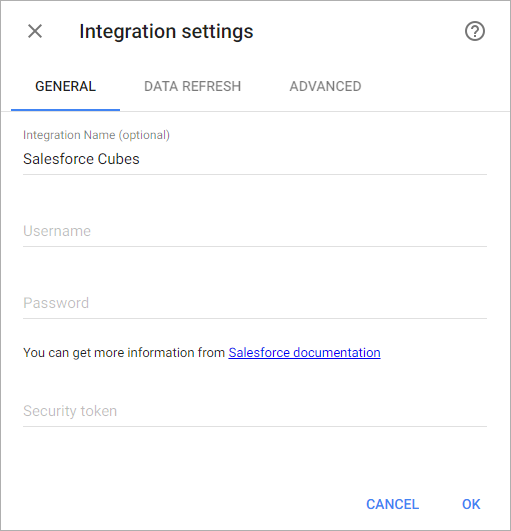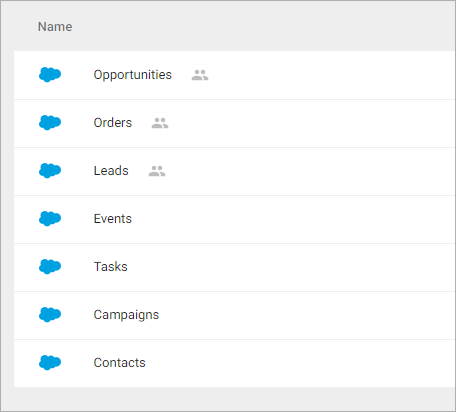There are two versions of Salesforce connector in Slemma. Select the one that works for you:
- Salesforce Reports – creates datasets based on your Salesforce reports. Slemma supports two types of Salesforce reports: SUMMARY (only primary information) and TABULAR. So when you create a dataset on Salesforce integration, you’ll see in the list only reports that have these types (one Slemma dataset for each Salesforce report). You should have REST API enabled for this integration.
- Salesforce Cubes – creates datasets based on your Salesforce dimensions and measures organized in Cubes. You should have BULK API enabled for this integration.
In this article, we’ll describe a Salesforce Cubes integration. If you need to learn more about Salesforce Reports, please read this article.
Here you’ll find the answers to the following questions:
- How to connect my Salesforce account with Slemma?
- How to get data from Salesforce Cubes?
- How to create a chart on my Salesforce Cubes integration?
Creating an Integration
From your Slemma account, head over to the Library page and click the plus button at the bottom right. Select Integration from the submenu.
In the following page, you can find Salesforce Cubes with one of the following ways:
- Scroll down and select Salesforce Cubes from the list of Integrations.
- Use search to find Salesforce Cubes from the list of Integrations.
- Choose Salesforce Cubes using All dropdown list > CRM.
You’ll see the Integration settings dialog window. You can select the frequency for the automatic updates on the DATA REFRESH tab, or set weeks settings on the ADVANCED tab. Leave this page open for now – we’ll need it to complete the setup.
Enter your username and password and leave this page open for now – we’ll need it to complete the setup.

From your Salesforce account, get your Security token and enter it to the Integration settings window. Click OK.
After authorization, you’ll be able to share the integration with either individuals or the entire Team, rename or remove the integration. To view the options available for the integration, right click it in the list.
Creating a Dataset
A dataset is a collection of data in a tabular format that is created on one of the possible data sources. The datasets can be used to create dashboards or individual charts.
To create a dataset, click your Salesforce Cubes integration in the list and select Browse datasets. From the following page, select which data you want to add to use in your charts.

NOTE: Cloud Service Integrations have prebuilt data sets that are not editable.
Click dataset’s name for a description of each dataset.
Represents a contact, which is an individual associated with an account. Dimensions +Custom Dimensions Measures +Custom Measures Templates Represents and tracks a marketing campaign, such as a direct mail promotion, webinar, or trade show. Dimensions +Custom Dimensions Measures +Custom Measures Templates Instead of starting from scratch when building a chart, you can use a pre-built visualization. Simply click one of the templates from the list and it will be added to the dashboard filled with your data. You can then edit and customize this template like a usual chart created by you. The following templates available for this dataset: Represents a business activity such as making a phone call or other to-do items. In the user interface, Task and Event records are collectively referred to as activities. Dimensions Measures Represents an event in the calendar. In the user interface, event and task records are collectively referred to as activities. Dimensions Measures Represents a prospect or potential Opportunity. Dimensions +Custom Dimensions Measures +Custom Measures Templates Instead of starting from scratch when building a chart, you can use a pre-built visualization. Simply click one of the templates from the list and it will be added to the dashboard filled with your data. You can then edit and customize this template like a usual chart created by you. The following templates available for this dataset: Represents an order associated with a contract or an account. Dimensions +Custom Dimensions Measures +Custom Measures Templates Instead of starting from scratch when building a chart, you can use a pre-built visualization. Simply click one of the templates from the list and it will be added to the dashboard filled with your data. You can then edit and customize this template like a usual chart created by you. The following templates available for this dataset: Represents an opportunity, which is a sale or pending deal. Dimensions +Custom Dimensions Measures +Custom Measures Templates Instead of starting from scratch when building a chart, you can use a pre-built visualization. Simply click one of the templates from the list and it will be added to the dashboard filled with your data. You can then edit and customize this template like a usual chart created by you. The following templates available for this dataset:
Creating a Chart
Click a dataset or integration and select Create dashboard/Create chart/Create presentation to start building a chart (please note that presentations are available starting from the Standard Plan).
From the next page, you can choose to create your own chart from scratch, or you can apply one of the templates we created.
- If you choose to build a new chart from scratch (“Blank” option), the Chart designer will open. Go here to learn how to create a chart in the Chart editor.
- If you choose a template, a new chart will be added to a dashboard/saved chart/presentation (depending on the way you start the chart creation).

